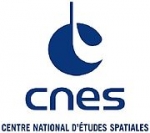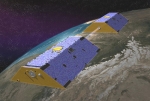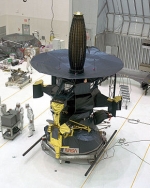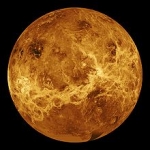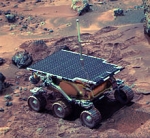Displaying items by tag: science
CNES
The Centre National d'Études Spatiales (CNES) (English: National Centre for Space Studies) is the French space agency.
Established under President Charles de Gaulle in 1961, its headquarters are located in central Paris and it is under the supervision of the French Ministries of Defence and Research. It operates out of the Guiana Space Centre, but also has payloads launched from space centres operated by other countries. CNES formerly was responsible for the training of French astronauts, the last active CNES astronauts transferred to the European Space Agency in 2001.
CNES concentrates on five areas:
- access to space
- civil applications of space
- sustainable development
- science and technology research
- security and defence
Mars Express
Mars Express is a space exploration mission being conducted by the European Space Agency (ESA). The Mars Express mission is exploring the planet Mars, and is the first planetary mission attempted by the agency. "Express" originally referred to the speed and efficiency with which the spacecraft was designed and built.However "Express" also describes the spacecraft's relatively short interplanetary voyage, a result of being launched when the orbits of Earth and Mars brought them closer than they had been in about 60,000 years.
Mars Express consists of two parts, the Mars Express Orbiter and the Beagle 2, a lander designed to perform exobiology and geochemistry research. Although the lander failed to land safely on the Martian surface, the Orbiter has been successfully performing scientific measurements since early 2004, namely, high-resolution imaging and mineralogical mapping of the surface, radar sounding of the subsurface structure down to the permafrost, precise determination of the atmospheric circulation and composition, and study of the interaction of the atmosphere with the interplanetary medium.
Due to the valuable science return and the highly flexible mission profile, Mars Express has been granted five mission extensions, the latest until 2014.
Some of the instruments on the orbiter, including the camera systems and some spectrometers, reuse designs from the failed launch of the Russian Mars 96 mission in 1996 (European countries had provided much of the instrumentation and financing for that unsuccessful mission). The basic design of Mars Express is based on ESA's Rosetta mission, on which a considerable sum was spent on development. The same design was also used for the Venus Express mission in order to increase reliability and reduce development cost and time.
ESA - ESAC (European Space Agency)
The European Space Astronomy Centre (ESAC) is the ESA's centre for space science, which means Astronomy as well as Solar System exploration. It is located in Villanueva de la Cañada, close to Madrid in Spain and hosts the science operation centres for all ESA astronomy and planetary missions together with their scientific archives.
Space telescopes are humankind’s eyes in the heavens: from their superior observing positions high above the Earth’s atmosphere, they provide us with astounding views of the Universe. ESAC is where those views are first studied – data on black holes and distant galaxies, from neighbouring planets and even from planets far beyond the Solar System are beamed back to the Madrid countryside. ESAC is thereby the ‘home’ of ESA’s space-telescope and planetary missions, the place from where their science operations are conducted, and where all of the scientific data that they produce are archived and made accessible to the world. ESAC is therefore one of ESA’s centres of excellence for space science. Missions represented a ESAC include (in alphabetical order) AKARI, Gaia, Herschel, INTEGRAL, LISA Pathfinder, Mars Express, Planck, Rosetta, Venus Express, and XMM-Newton.
In addition to deep space and solar system exploration ESAC hosts the data processing of SMOS, a satellite observing the earth, as well as the Space Situation Awareness (SSA) programm.
ESA’s deep-space antenna in Europe, located in Cebreros, Avila, is an essential support to the activities of ESAC. Inaugurated in September 2005, Cebreros features a new, highly accurate pointing control system and a 35-metre antenna that allow ESA to gather data from distant missions to Mercury, Venus, Mars and beyond.
ESAC is also involved in ESA missions conducted in collaboration with other space agencies. One example is Akari, a Japanese-led mission to carry out an infrared sky survey, launched on 21 February 2006. Future collaborative programmes also include the NASA-led James Webb Space Telescope, the successor to the Hubble Space Telescope.
In addition, ESAC also hosts the Spanish Laboratory for Space Astrophysics and Fundamental Physics (LAEFF), an innovative research facility aimed mainly at encouraging young Spanish scientists to enter the fields of astrophysics and fundamental physics.
The ESAC centre in Villafranca del Castillo, within the town limits of Villanueva de la Cañada, is located 30 km west of Madrid in the Guadarrama Valley. Evergreen oaks and the ruins of a nearby 15th century castle make a spectacular backdrop for the high-tech vista of ESA's large antennas and modern buildings. The Cebreros site is in Avila, about 90 km from Madrid and 65 km from ESAC.
XMM-Newton
The XMM-Newton (X-ray Multi-Mirror Mission - Newton) is an orbiting X-ray observatory launched by ESA in December 1999 on a Ariane 5 rocket. It is named in honor of Sir Isaac Newton.
Its mission is turned towards deep space and aimes to increasing our knowledge of very hot objects created when the Universe was very young,
Originally known as the High Throughput X-ray Spectroscopy Mission it was placed in a very eccentric 48 hour elliptical orbit at 40°; at its apogee it is nearly 114,000 kilometres (71,000 mi) from Earth, while theperigee is only 7,000 kilometres (4,300 mi)
The satellite weighs 3,800 kilograms (8,400 lb), is 10 metres (33 ft) long and 16 metres (52 ft) in span with its solar arrays deployed. It holds three X-ray telescopes, developed by Media Lario of Italy, each of which contains 58 Wolter-type concentric mirrors. The combined collecting area is 4,300 cm². The three European Photon Imaging Cameras (EPIC) are sensitive over the energy range 0.2 keV to 12 keV. Other instruments onboard are two reflection grating spectrometers which are sensitive below ~2 keV, and a 30 centimetres (12 in) diameter Ritchey-Chretien optical/UV telescope.
The mission was proposed in 1984 and approved in 1985; a project team was formed in 1993 and development work began in 1996. The satellite was constructed and tested from March 1997 to September 1999. Launched in Dec 1999, in-orbit commissioning started Jan 2000. First images published Feb 2000. The original mission lifetime was two years, it has now been extended for further observations until at least 2010, and again until 2012, and technically could operate until 2018.
Observations are managed and archived at the European Space Astronomy Centre (formerly known as VILSPA) at Villafranca, Spain. The data are processed at the XMM-Newton Survey Science Centre at the University of Leicester, England.
The European satellite XMM-Newton (X-ray Multi Mirror), built under contract to ESA by a consortium of 35 European companies with Astrium as prime contractor, by far excels its predecessor, the Astrium-built ROSAT satellite.
GRACE
The Gravity Recovery And Climate Experiment (GRACE), a joint mission of NASA and the German Space Agency, has been making detailed measurements of Earth's gravity field since its launch in March 2002.
Gravity is determined by mass. By measuring gravity, GRACE shows how mass is distributed around the planet and how it varies over time. GRACE data are important tools for studying Earth's ocean, geology, and climate.
GRACE is a collaborative endeavor involving the Center for Space Research at the University of Texas, Austin; NASA's Jet Propulsion Laboratory, Pasadena, Calif.; the German Space Agency and Germany's National Research Center for Geosciences, Potsdam. The Jet Propulsion Laboratory is responsible for the overall mission management under the NASA ESSP program.
The principal investigator is Dr. Byron Tapley of the University of Texas Center for Space Research, and the co-principal investigator is Dr. Christoph Reigber of the GeoForschungsZentrum (GFZ) Potsdam.
The GRACE satellites were launched from Plesetsk Cosmodrome, Russia on a Rockot (SS-19 + Breeze upper stage) launch vehicle, on March 17, 2002.
GRAIL
GRAIL =Gravity Recovery and Interior Laboratory
The Gravity Recovery and Interior Laboratory (GRAIL) is an American lunar science mission in NASA's Discovery Program, which will use high-quality gravitational field mapping of the Moon to determine its interior structure. The two small spacecraft GRAIL A and GRAIL B were launched on 10 September 2011 aboard a single launch vehicle: the most-powerful configuration of a Delta II, the 7920H-10. GRAIL A separated from the rocket about nine minutes after launch, GRAIL B followed about eight minutes later. They will arrive at their orbits around the Moon 24 hours apart.
The science phase of the mission will last for 90 days. Following the science phase (or extended mission phase), a five-day decommissioning period is planned, after which the spacecraft will impact the lunar surface in about 40 days.[6] The gravity mapping technique is similar to that used by Gravity Recovery and Climate Experiment (GRACE), and the spacecraft design is based on XSS-11.
Unlike the Apollo program missions, which took three days to reach the Moon, GRAIL will make use of a three- to four-month low-energy trans-lunar cruise via the Sun-Earth Lagrange point L1 to reduce fuel requirements, protect instruments and reduce the velocity of the two spacecraft at lunar arrival to help achieve the extremely low 50 km (31 mi) orbits with separation between the spacecraft (arriving 24 hours apart) of 175 to 225 km (109 to 140 mi). The very tight tolerances in the flight plan leaves little room for error correction leading to a launch window lasting one second and providing only two launch opportunities per day.
The planned orbital insertion dates are December 31, 2011 (for GRAIL-A) and January 1, 2012 (for GRAIL-B).
NASA's Jet Propulsion Laboratory manages the project.
The GRAIL mission will place two spacecraft into the same orbit around the Moon. As they fly over areas of greater and lesser gravity, caused both by visible features such as mountains and craters and by masses hidden beneath the lunar surface, they will move slightly toward and away from each other. An instrument aboard each spacecraft will measure the changes in their relative velocity very precisely, and scientists will translate this information into a high-resolution map of the Moon's gravitational field.
This gravity-measuring technique is essentially the same as that of the Gravity Recovery And Climate Experiment (GRACE), which has been mapping Earth's gravity since 2002.
Objectives
GRAIL's engineering objectives are to enable the science objectives of mapping lunar gravity and using that information to increase understanding of the Moon's interior and thermal history. Getting the two spacecraft where they need to be, when they need to be there, requires an extremely challenging set of maneuvers never before carried out in solar system exploration missions. Mission design
The two GRAIL spacecraft will be launched together and then will fly similar but separate trajectories to the Moon after separation from the launch vehicle, taking about 3 to 4 months to get there. They will spend about 2 months reshaping and merging their orbits until one spacecraft is following the other in the same low-altitude, near-circular, near-polar orbit, and they begin formation-flying. The next 82 days will constitute the science phase, during which the spacecraft will map the Moon's gravitational field.
Spacecraft and payload
The two GRAIL spacecraft are near-twins, each about the size of a washing machine, with minor differences resulting from the need for one specific spacecraft (GRAIL-A) to follow the other (GRAIL-B) as they circle the Moon.
The science payload on each spacecraft is the Lunar Gravity Ranging System, which will measure changes in the distance between the two spacecraft down to a few microns -- about the diameter of a red blood cell. Each spacecraft will also carry a set of cameras for MoonKAM, marking the first time a NASA planetary mission has carried instruments expressly for an education and public outreach project.
ISSI - the International Space Science Institute
The International Space Science Institute (ISSI) is an Institute of Advanced Studies based in Bern, Switzerland. The institute's work is interdisciplinary, focusing on the study of the solar system, and encompasses planetary sciences, astrophysics, cosmology, astrobiology, and the Earth sciences. A main activity is the interpretation of experimental data collected by space research missions.
ISSI is a non-profit organization and a foundation under Swiss law. ISSI operations are supported by grants from the European Space Agency, the University of Bern, the Swiss Confederation and the Swiss National Science Foundation (SNF).
It was established in 1995. Primary initial capital for the ISSI was provided by Oerlikon Space AG.
Mission
ISSI is an Institute of Advanced Studies where scientists from all over the world meet in a multi- and interdisciplinary setting to reach out for new scientific horizons. The main function is to contribute to the achievement of a deeper understanding of the results from different space missions, ground based observations and laboratory experiments, and adding value of those results through multidisciplinary research in the framework of International Teams, Workshops, Working Groups, Forums or as individual Visiting Scientists. The program of ISSI covers a widespread spectrum of disciplines from the physics of the solar system and planetary sciences to astrophysics and cosmology, and from Earth sciences to astrobiology.
Galileo (NASA spacecraft)
The Galileo spacecraft was an unmanned spacecraft sent by NASA to study the planet Jupiter and its moons. Named after the astronomer and Renaissance pioneer Galileo Galilei, it was launched on October 18, 1989 by the Space Shuttle Atlantis on the STS-34 mission. It arrived at Jupiter on December 7, 1995, a little more than six years later, via gravitational assist flybys of Venus and Earth.
Despite suffering from antenna problems, Galileo conducted the first asteroid flyby near 951 Gaspra, discovered the first asteroid moon, Dactyl, around the asteroid 243 Ida, and was the first spacecraft to orbit Jupiter. It furthermore launched the first probe into Jupiter's atmosphere.
The spacecraft measured the atmospheric composition of Jupiter and directly observed ammonia clouds, which seem to be created by an outflow from the lower depths of Jupiter's atmosphere. Galileo also registered Io's volcanism and the plasma interactions between its and Jupiter's atmospheres. Other studies gave support for the popular theory of liquid oceans under the icy surface of Europa. There were also indications of similar liquid-saltwater layers under the surfaces of Ganymede and Callisto, while Ganymede was shown to possess a magnetic field. New evidence was also found for the existence of exospheres around Europa, Ganymede, and Callisto.
It was furthermore discovered that Jupiter's faint ring system is formed by dust from impacts on the four small inner moons. The extent and structure of Jupiter's magnetosphere was also mapped.
Galileo also provided the only direct observation of Comet Shoemaker-Levy 9's impact into the atmosphere of Jupiter in 1994.
On September 21, 2003, after 14 years in space and 8 years of service in the Jovian system, Galileo's mission was terminated by sending the orbiter into Jupiter's atmosphere at a speed of nearly 50 kilometres per second to avoid any chance of it contaminating local moons with bacteria from Earth. Of particular concern was the ice-crusted moon Europa, which, thanks to Galileo, scientists now suspect harbors a potentially life-supporting saltwater ocean beneath its surface.
SAR
Synthetic-aperture radar (SAR) is a form of radar whose defining characteristic is its use of relative motion between an antenna and its target region to provide distinctive long-term coherent-signal variations that are exploited to obtain finer spatial resolution than is possible with conventional beam-scanning means. It originated as an advanced form of side-looking airborne radar (SLAR).
SAR is usually implemented by mounting, on a moving platform such as an aircraft or spacecraft, a single beam-forming antenna from which a target scene is repeatedly illuminated with pulses of radio waves at wavelengths anywhere from a meter down to millimeters. The many echo waveforms received successively at the different antenna positions are coherently detected and stored and then post-processed together to resolve elements in an image of the target region.
Current (2010) airborne systems provide resolutions to about 10 cm, ultra-wideband systems provide resolutions of a few millimeters, and experimental terahertz SAR has provided sub-millimeter resolution in the laboratory.
SAR images have wide applications in remote sensing and mapping of the surfaces of both the Earth and other planets. SAR can also be implemented as "inverse SAR" by observing a moving target over a substantial time with a stationary antenna.
Mars Pathfinder
Mars Pathfinder (MESUR Pathfinder) was an American spacecraft that landed a base station with roving probe onMars in 1997. It consisted of a lander, renamed the Carl Sagan Memorial Station, and a lightweight (10.6 kilograms/23 pounds) wheeled robotic rover named Sojourner.
Launched on December 4, 1996 by NASA aboard a Delta II booster a month after the Mars Global Surveyor was launched, it landed on July 4, 1997 on Mars' Ares Vallis, in a region called Chryse Planitia in the Oxia Palus quadrangle. The lander then opened, exposing the rover which conducted many experiments on the Martian surface. The mission carried a series of scientific instruments to analyze the Martian atmosphere, climate, geology and the composition of its rocks and soil. It was the second project from NASA's Discovery Program, which promotes the use of low-cost spacecraft and frequent launches under the motto "cheaper, faster and better" promoted by the then administrator, Daniel Goldin. The mission was directed by the Jet Propulsion Laboratory (JPL), a division of the California Institute of Technology, responsible for NASA's Mars Exploration Program.

